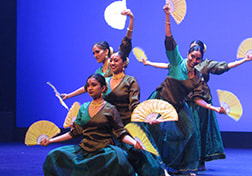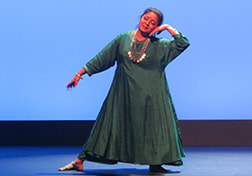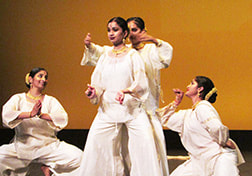
BY SONAM MIRPURI
FULLERTON, CA - Narratives can be expressed in a variety of forms. One of the many ways a tale can be conveyed is through dance. Not only is this method effective, it is entertaining as well. In 2003 following her years of living, performing, teaching, and choreographing in the US for over 20 years, Ramya Harishankar was ready...
FULLERTON, CA - Narratives can be expressed in a variety of forms. One of the many ways a tale can be conveyed is through dance. Not only is this method effective, it is entertaining as well. In 2003 following her years of living, performing, teaching, and choreographing in the US for over 20 years, Ramya Harishankar was ready...
to do something different. Celluloid Classics was brought to life in collaboration with Radhika Shurajit, a trained Bharatanatyam dancer who has worked extensively in television and films.
“That performance was before its time – a unique coming together of classical and popular genres,” said Harishankar.
In celebration of their 35th Anniversary, Harishankar and the Arpana Dance Company in partnership with Radhika Shurajit came together once again to continue the idea of Celluloid Classics and bring a second rendition,Celluloid Classics 2.
The visually creative dance performances were brought to life on Septr 16 at the Campus Theatre Fullerton College here.
Hoping that this production would maintain the authenticity of previous dance forms was one of the aspirations behind this presentation. Harishanka said Celluloid Classics 2 was planned to preserve the integrity of both classical/folk dance and film music.
Beginning with a religious piece “Gananayaka,” which honored Ganesha. The dasncers gracefully and appropriately revered Ganesha in hopes he would remove any hindrances which may come.
Harishankar came to the stage to introduce the upcoming pieces.
“KatrinileVarumGeetham,” told the story of a young lad of blue hue who stood playing the flute and how his music was carried by the breezes. “DolaDola,” brought to life Raas/Dandiya from Gujarat and Rajastan. “ManavanVandanAdi,” depicted the story of a king who embarked on a quest to devote himself to spirituality. “AaMogavu,” was not a dance song, it was originally filmed as a duet in which the main male character is appreciating the magnificence and appeal of his love. Four dancers beautifully told the story of the protagonist and his leading lady.
In between each piece there was a brief introduction either by Harishankar would come to the stage to say a few words or via a video “Mouliyil,” demonstrated a popular folk dance form from Kerala.“Chanda He Tu,” was a well-known track which portrayed Vatsalya Rasa, the love between a mother and her young child. This song brought Harishankar herself to the stage which was highly appreciated by the audience.
After a short intermission, Harishankar came back on stage to perform “Kadhal Siragai,” which told the story of a distressed heroine who is longing for her love, who does not return home. This piece presented a form of BharataNatyam known as padams, love songs, which explore numerous circumstances in relationships.
Celluloid Classics 2 brought a variety of Indian languages together on stage. Songs were presented in six different Indian languages.
“EruvaakaSagaaro,” described the changes that came about when there were land reforms in India and celebrates harvest. The dance gave a glimpse of the environmental and political issues Indian society faced and was greatly appreciated by the audience.“Dolarey,” was also a hit. “Love Birds,” in Tamil, originally starred legendary actor and later Chief Minister of Tamil Nadu, Late MG Ramachandran and was a tribute to him on his birth centenary year.
“ThayeYashoda,” brought to life a popular 18th century composition of Oothukadu Venkata Subbier which has been used as the base for this exploration of Carnatic music and Jazz.
“Mukunda Mukunda,” explored the different characteristics of Krishna as well as his 10 incarnations.“UnnaiKaanadha,” , was originally choreographed by Kathak legend, Pandit Birju Maharaj, for the film Viswaroopam. It combines Kathak with Bharat Natyam vocabulary. Ending on a high note, the finale performance evoked a sense of patriotism in “VandeMataram.” The dancers held the Indian flag and the American flag paying homage to the two `mothers.’
All the participants and Harishankar came on stage to take their final bow, and were given a standing ovation.
“That performance was before its time – a unique coming together of classical and popular genres,” said Harishankar.
In celebration of their 35th Anniversary, Harishankar and the Arpana Dance Company in partnership with Radhika Shurajit came together once again to continue the idea of Celluloid Classics and bring a second rendition,Celluloid Classics 2.
The visually creative dance performances were brought to life on Septr 16 at the Campus Theatre Fullerton College here.
Hoping that this production would maintain the authenticity of previous dance forms was one of the aspirations behind this presentation. Harishanka said Celluloid Classics 2 was planned to preserve the integrity of both classical/folk dance and film music.
Beginning with a religious piece “Gananayaka,” which honored Ganesha. The dasncers gracefully and appropriately revered Ganesha in hopes he would remove any hindrances which may come.
Harishankar came to the stage to introduce the upcoming pieces.
“KatrinileVarumGeetham,” told the story of a young lad of blue hue who stood playing the flute and how his music was carried by the breezes. “DolaDola,” brought to life Raas/Dandiya from Gujarat and Rajastan. “ManavanVandanAdi,” depicted the story of a king who embarked on a quest to devote himself to spirituality. “AaMogavu,” was not a dance song, it was originally filmed as a duet in which the main male character is appreciating the magnificence and appeal of his love. Four dancers beautifully told the story of the protagonist and his leading lady.
In between each piece there was a brief introduction either by Harishankar would come to the stage to say a few words or via a video “Mouliyil,” demonstrated a popular folk dance form from Kerala.“Chanda He Tu,” was a well-known track which portrayed Vatsalya Rasa, the love between a mother and her young child. This song brought Harishankar herself to the stage which was highly appreciated by the audience.
After a short intermission, Harishankar came back on stage to perform “Kadhal Siragai,” which told the story of a distressed heroine who is longing for her love, who does not return home. This piece presented a form of BharataNatyam known as padams, love songs, which explore numerous circumstances in relationships.
Celluloid Classics 2 brought a variety of Indian languages together on stage. Songs were presented in six different Indian languages.
“EruvaakaSagaaro,” described the changes that came about when there were land reforms in India and celebrates harvest. The dance gave a glimpse of the environmental and political issues Indian society faced and was greatly appreciated by the audience.“Dolarey,” was also a hit. “Love Birds,” in Tamil, originally starred legendary actor and later Chief Minister of Tamil Nadu, Late MG Ramachandran and was a tribute to him on his birth centenary year.
“ThayeYashoda,” brought to life a popular 18th century composition of Oothukadu Venkata Subbier which has been used as the base for this exploration of Carnatic music and Jazz.
“Mukunda Mukunda,” explored the different characteristics of Krishna as well as his 10 incarnations.“UnnaiKaanadha,” , was originally choreographed by Kathak legend, Pandit Birju Maharaj, for the film Viswaroopam. It combines Kathak with Bharat Natyam vocabulary. Ending on a high note, the finale performance evoked a sense of patriotism in “VandeMataram.” The dancers held the Indian flag and the American flag paying homage to the two `mothers.’
All the participants and Harishankar came on stage to take their final bow, and were given a standing ovation.




 RSS Feed
RSS Feed
